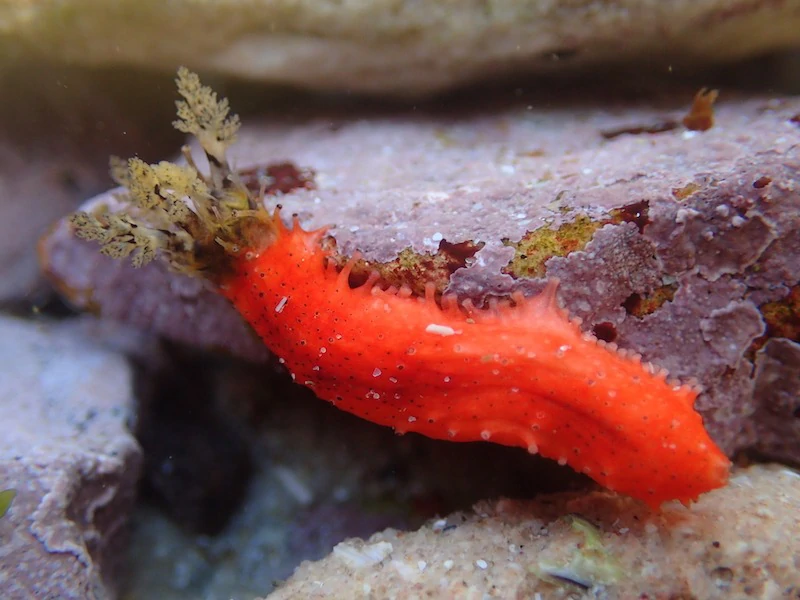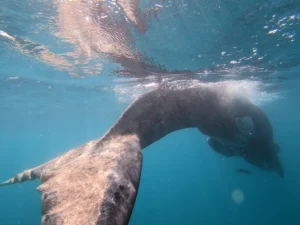Echinoderms are a phylum of marine animals commonly characterised by popular spiny skinned species such as sea stars and sea urchins. An equally curious yet perhaps lesser known member of this phylum is the sea cucumber, which lacks distinctive spines and is typically soft and flexible and can vary in size from a few centimetres to over a metre in length. Sea cucumbers have elongated bodies covered with leathery skin that is often adorned with numerous tube feet and spines.
Approximately 115 species of sea cucumbers have been recorded in South African waters, according to the South African National Biodiversity Institute (SANBI). The country’s diverse range of marine ecosystems, including rocky reefs, sandy bottoms, seagrass beds, and estuaries, provide ample habitat for a variety of sea cucumber species. Their occurrence and abundance in these habitats may depend on numerous factors, such as water temperature, nutrient availability, and predation pressure.
Despite their rudimentary appearance, sea cucumbers play an essential role in nutrient cycling and energy transfer in marine ecosystems. As deposit feeders, they consume detritus and organic matter that settles on the seafloor. Through this breaking down of natural debris, they recycle the nutrients thereby making them available to other organisms in the food chain. When freediving and snorkeling in Cape Town, the presence of sea cucumbers typically indicates that the dive site is in a healthy state.

Sea cucumbers are generally considered to be sedentary animals and tend to stay in one location for extended periods, using their tube feet to anchor themselves to the substrate or burrow into the sediment. Although tricky to observe with the naked eye, sea cucumber species are capable of limited movement, either by using their tube feet to slowly crawl along or by swimming using rhythmic contractions of their muscles. Some species can even exhibit a rapid escape response by forcefully expelling water from their body cavity to propel themselves away, to prevent them from ending up as prey! Sea cucumbers are at risk of predation primarily by crabs, fish, and sea stars. In addition to these larger predators, sea cucumbers are also vulnerable to a variety of parasites and smaller organisms, such as polychaete worms and copepods, which can feed on their body tissues or eggs. Along with fleeing as a protective mechanism to avoid predation, some species of sea cucumbers have further evolved specialised defence mechanisms, including the ability to eject their internal organs, or toxic secretions which deter predators.
The reproductive strategies of echinoderms can vary widely between species; however, most sea cucumber species are dioecious, meaning that they have separate sexes. They reproduce by releasing gametes into the water, where fertilisation takes place. Larvae develop into planktonic juveniles, which eventually settle on the seafloor and develop into adult sea cucumbers.

The protection and management of sea cucumbers is an important aspect of marine conservation efforts in South Africa and worldwide. These curious creatures are in demand for their perceived medicinal properties, as well as for their culinary value in certain cultures. In South Africa, sea cucumbers are harvested and exported, and the country has had to implement various measures to manage and protect these populations. However, illegal harvesting and trade of sea cucumbers continue to be a significant challenge, as these activities can lead to the depletion of sea cucumber populations and disrupt ecosystem functioning through overexploitation and habitat destruction by harmful harvesting techniques. Some species of sea cucumbers are threatened and/or protected, with the sandfish sea cucumber (Holothuria scabra) listed as “vulnerable” by the International Union for Conservation of Nature (IUCN) due to its decline in population size and distribution.
In response to these threats, the South African government has implemented various measures to protect sea cucumbers, such as setting fishing quotas, regulating fishing methods, and establishing marine protected areas. Additionally, there are national and international regulations in place to protect certain species of sea cucumbers, such as those listed under the Convention on International Trade in Endangered Species of Wild Fauna and Flora (CITES).
Despite their peculiar appearance, sea cucumbers fulfil an integral role in the functioning of marine ecosystems, and so the protection and effective management of these species is imperative for the health of oceans across the globe.



